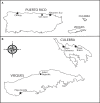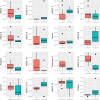Minimal impacts of invasive Scaevola taccada on Scaevola plumieri via pollinator competition in Puerto Rico
- PMID: 38332769
- PMCID: PMC10850390
- DOI: 10.3389/fpls.2024.1281797
Minimal impacts of invasive Scaevola taccada on Scaevola plumieri via pollinator competition in Puerto Rico
Abstract
Introduction: Scaevola taccada and Scaevola plumieri co-occur on shorelines of the Caribbean. Scaevola taccada is introduced in this habitat and directly competes with native dune vegetation, including S. plumieri, a species listed as locally endangered and threatened in Caribbean locations. This study addresses whether the invasive S. taccada also impacts the native S. plumieri indirectly by competing for pollinators and represents the first comparative study of insect visitation between these species.
Methods: Insect visitation rates were measured at sites where species co-occur and where only the native occurs. Where species cooccur, insect visitors were captured, identified and analyzed for the pollen they carry. Pollen found on open-pollinated flowers was analyzed to assess pollen movement between the two species. We also compared floral nectar from each species by measuring volume, sugar content, and presence and proportions of amine group containing constituents (AGCCs).
Results: Our results demonstrate that both species share insect visitors providing the context for possible pollinator competition, yet significant differences in visitation frequency were not found. We found evidence of asymmetrical heterospecific pollen deposition in the native species, suggesting a possible reproductive impact. Insect visitation rates for the native were not significantly different between invaded and uninvaded sites, suggesting that the invasive S. taccada does not limit pollinator visits to S. plumieri. Comparisons of nectar rewards from the invasive and the native reveal similar volumes and sugar concentrations, but significant differences in some amine group containing constituents that may enhance pollinator attraction.
Conclusion: Our analysis finds no evidence for pollination competition and therefore S. taccada's main impacts on S. plumieri are through competitive displacement and possibly through reproductive impacts as a consequence of heterospecific pollen deposition.
Keywords: Goodeniaceae; Scaevola plumieri; Scaevola taccada; invasive; pollination.
Copyright © 2024 Swensen, Gomez, Piasecki-Masters, Chime, Wine, Rodriguez, Conklin and Melcher.
Conflict of interest statement
The authors declare that the research was conducted in the absence of any commercial or financial relationships that could be construed as a potential conflict of interest. The author(s) declared that they were an editorial board member of Frontiers, at the time of submission. This had no impact on the peer review process and the final decision.
Figures






References
-
- Acevedo-Rodriguez P., Strong M. T. (2012). “Catalogue of seed plants of the West Indies,” in Smithsonian contributions to botany no. 98 (Washington, D.C: Smithsonian Institution Scholarly Press; ).
-
- Aluri J. S. R., Kunuku V. R., Banisetti D. K. (2019). Pollination ecology of the coastal pantropical hermaphroditic shrub Scaevola taccada (Goodeniaceae). Phytologia Balcanica 25 (2), 191–202.
-
- Bates D., Maechler M., Bolker B., Walker S. (2015). Fitting linear mixed-effects models using lme4. J. Stat. Software 67 (1), 1–48. doi: 10.18637/jss.v067.i01 - DOI
-
- Beattie A. J. (1971). A technique for the study of insect-borne pollen. Pan-Pacific Entomologist 47, 82. Available at: https://digitalcommons.usu.edu/bee_lab_ba/8.
LinkOut - more resources
Full Text Sources

